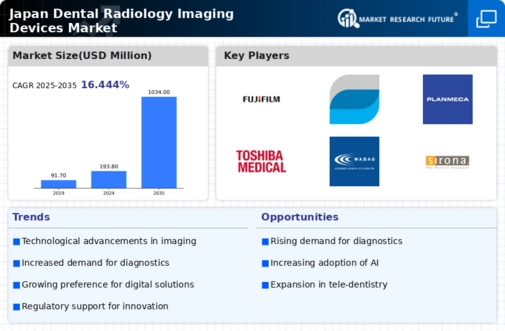Increasing Dental Tourism
The rise of dental tourism in Japan is emerging as a noteworthy driver for the dental radiology-imaging-devices market. As international patients seek high-quality dental care at competitive prices, Japanese dental clinics are enhancing their service offerings, including advanced imaging technologies. The influx of foreign patients necessitates the use of state-of-the-art radiology-imaging devices to ensure accurate diagnoses and effective treatment plans. Reports indicate that dental tourism in Japan has seen a growth rate of around 10% annually, prompting clinics to invest in cutting-edge imaging solutions to attract and retain patients. This trend not only boosts the market for dental radiology-imaging devices but also encourages clinics to maintain high standards of care, thereby enhancing the overall reputation of Japan as a dental tourism destination.
Rising Geriatric Population
The increasing geriatric population in Japan is a pivotal driver for the dental radiology-imaging-devices market. As the elderly demographic expands, the prevalence of dental issues such as periodontal disease and tooth decay rises. This necessitates advanced imaging technologies for accurate diagnosis and treatment planning. According to recent statistics, approximately 28% of the Japanese population is aged 65 and older, which is projected to increase. Consequently, dental practices are likely to invest in sophisticated imaging devices to cater to this demographic's needs, thereby propelling market growth. The demand for high-quality imaging solutions is expected to surge, as practitioners seek to enhance patient outcomes and streamline treatment processes. This trend indicates a robust market potential for innovative dental radiology-imaging devices tailored to the unique requirements of older patients.
Growing Awareness of Oral Health
There is a notable increase in awareness regarding oral health among the Japanese population, which serves as a significant driver for the dental radiology-imaging-devices market. Public health campaigns and educational initiatives have emphasized the importance of regular dental check-ups and preventive care. As a result, more individuals are seeking dental services, leading to a higher demand for diagnostic imaging. The market is expected to witness a growth rate of approximately 5% annually as patients become more proactive about their oral health. This heightened awareness encourages dental practitioners to adopt advanced imaging technologies to meet patient expectations and improve diagnostic capabilities. Consequently, the dental radiology-imaging-devices market is likely to expand as practitioners invest in state-of-the-art equipment to provide comprehensive care.
Government Initiatives and Funding
Government initiatives aimed at improving healthcare infrastructure in Japan are positively impacting the dental radiology-imaging-devices market. The Japanese government has been actively promoting dental health through various programs and funding opportunities. These initiatives often include subsidies for dental practices to upgrade their equipment, including imaging devices. Such financial support encourages dental professionals to invest in modern technologies, thereby enhancing diagnostic capabilities. Additionally, the government's focus on preventive care aligns with the need for advanced imaging solutions, as early detection of dental issues is crucial. This supportive environment is likely to foster growth in the dental radiology-imaging-devices market, as practitioners are incentivized to adopt innovative technologies that improve patient care.
Technological Integration in Dental Practices
The integration of advanced technologies in dental practices is significantly influencing the dental radiology-imaging-devices market. Innovations such as digital radiography, 3D imaging, and artificial intelligence are becoming increasingly prevalent in Japan. These technologies not only improve diagnostic accuracy but also enhance workflow efficiency within dental clinics. For instance, digital radiography reduces radiation exposure by up to 80%, making it a safer option for patients. Furthermore, the ability to instantly view and manipulate images allows for better treatment planning and patient communication. As dental practitioners recognize the benefits of these technologies, investment in modern imaging devices is likely to rise. This trend suggests a shift towards more technologically advanced dental practices, which could lead to a substantial increase in the demand for cutting-edge radiology-imaging devices.























Leave a Comment